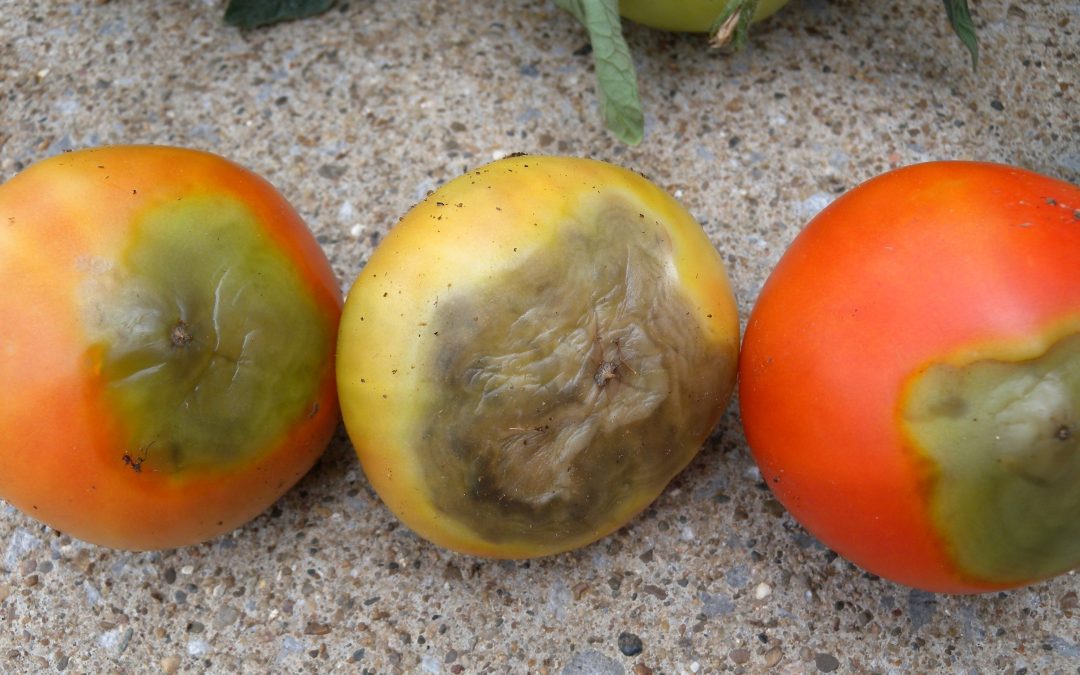
by Molly Jameson | Apr 3, 2025
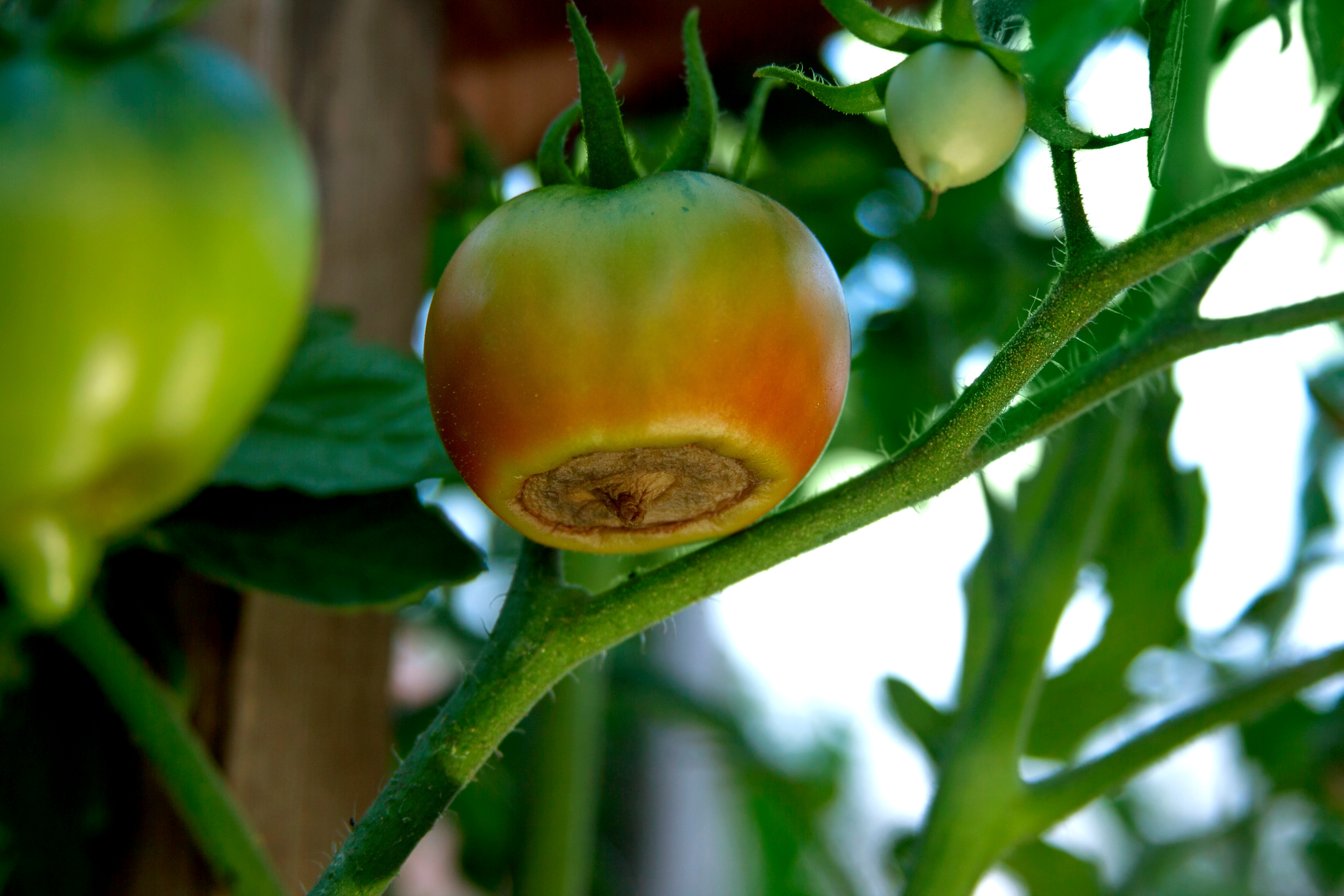
A promising start, until blossom-end rot strikes. Keep your tomatoes healthy by maintaining consistent watering, balanced fertilization, and proper soil pH. Photo by Mila Makhova, Adobe.
It’s the moment you’ve been waiting for – after weeks of careful tending, the first set of tomatoes is beginning to form. Each day, you check your plants with anticipation, imagining the juicy, homegrown harvest to come. But one morning, while inspecting your developing tomatoes, you notice some have sunken, leathery brown patches at the blossom end. Your excitement turns to frustration – what went wrong?
Blossom-end rot is one of the most frustrating disorders for home gardeners and commercial growers alike. This common issue appears as a sunken, leathery brown or black spot at the blossom end of tomatoes, usually occurring on the first fruits the plant produces. Though it may look like a disease, blossom-end rot is actually a physiological disorder caused by calcium deficiency in the fruit. Understanding what triggers it and how to prevent it can help ensure a healthy tomato harvest.
What Causes Blossom-End Rot?
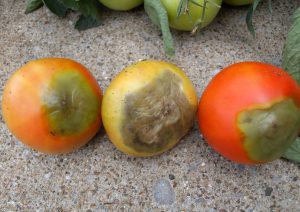
Blossom-end rot can appear at any stage of ripening. These tomatoes developed severe lesions due to calcium deficiency caused by inconsistent watering. Photo by Brenda Kennedy, University of Kentucky, Bugwood.org.
Although blossom-end rot results from calcium deficiency in the fruit, it is rarely caused by a lack of calcium in the soil. Instead, the issue arises when calcium uptake is disrupted due to fluctuations in soil moisture, root damage, or excessive fertilization.
Calcium moves through plants via active transpiration, traveling with water as it evaporates from above-ground plant parts. Since leaves lose more water through transpiration than fruits, calcium is more likely to accumulate in leaves rather than being directed toward developing tomatoes. This imbalance is made worse by excessive nitrogen fertilization, which encourages leafy growth and further diverts calcium away from the fruit.
The following factors contribute to blossom-end rot:
- Inconsistent Watering. Calcium is transported through water in the plant, so periods of drought followed by excessive moisture can hinder uptake.
- Excess Nitrogen Fertilization. Too much nitrogen, especially in ammonium form, can interfere with calcium absorption and promote excessive foliage growth at the expense of fruit development.
- Soil pH Imbalance. Acidic soils (below pH 5.5) can limit calcium availability to plants.
- Root Damage. Over-cultivation or compacted soils can reduce root function, limiting nutrient uptake.
Prevention Strategies
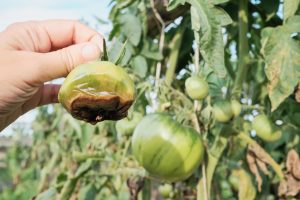
A severe case of blossom-end rot on an unripe tomato. Photo by Col Nihko, Adobe.
Blossom-end rot cannot be reversed once it appears, but often the plant will produce healthy fruit as the season progresses. Several cultural practices can help prevent it from occurring in the first place.
- Maintain Consistent Soil Moisture. Water deeply and consistently, adjusting for temperature and weather conditions. As a general rule, tomatoes need about an inch of water per week, with an additional half-inch for every 10-degree increase above 60°F. In hot summer months, when temperatures reach the 80s and 90s, this means tomatoes may require closer to two inches of water per week to maintain adequate soil moisture. Mulching with straw, pine needles, or shredded leaves helps regulate soil moisture and reduce evaporation. It is also important to avoid letting the soil dry out completely between waterings to ensure steady calcium uptake by the plant.
- Test and Amend Soil. Vegetable gardens, especially those rich in compost, often contain adequate amounts of calcium, but its availability depends on factors like soil pH and consistent watering. A soil test can determine if nutrient or pH adjustments are needed. If the soil pH is below 6.0, applying lime can help raise it to the optimal range of 6.0–6.5, improving calcium availability to plants. If a soil test confirms low calcium levels, adding gypsum (calcium sulfate) can provide a supplemental source of calcium without altering soil pH.
- Fertilize Properly. Using a balanced fertilizer with moderate nitrogen is key to preventing blossom-end rot. Avoid high-ammonium formulations, as they can interfere with calcium absorption. Excess fertilization early in the season encourages vigorous leaf growth, diverting calcium away from fruit development and increasing the risk of blossom-end rot.
- Choose the Right Tomato Varieties. Cherry and other small-fruited tomato varieties tend to be less prone to blossom-end rot than larger slicing types, making them a good option for gardeners concerned about calcium-related issues.
What to Do If You See Blossom-End Rot
Once symptoms appear, affected fruit will not recover, but the plant can still produce healthy tomatoes with proper care. Remove damaged fruit to encourage new growth and address the underlying moisture and nutrient issues. If watering and fertilization practices are adjusted, subsequent fruits should develop normally.
For more information on identifying blossom-end rot, visit the UF/IFAS Plant Pathology U-scout page: https://plantpath.ifas.ufl.edu/u-scout/tomato/blossom-end-rot.html.

by Julie McConnell | Apr 3, 2025
Some years it can be hard to tell that the season has shifted from winter to spring in Northwest Florida, but this year we are seeing ideal temperatures for summer vegetable gardens as we shift into April. Soil temperature is affected by ambient temperature and the last few weeks of warm weather has helped to make the ground more conducive to germination of warm season seeds and support growth of transplants. If you have not started your garden yet, do not despair, you still have time to get things growing!
Below is a short list of ideas for your vegetable garden, and you can find more detailed information in the Florida Vegetable Gardening Guide.
Direct seed (plant seeds directly into the garden instead of transplant) recommendations:
Transplant (grown from seed at home or purchased in the garden center) recommendations:
More helpful resources for Florida vegetable gardeners can be found below:
Growing Vegetables in Containers
Harvesting and Storing Vegetables
Starting from Seed

by Matt Lollar | Jan 2, 2025
It’s a new year and if you’re still contemplating resolutions, here’s one for you. Stay organized with your vegetable planting schedule. Since it’s January, let’s start with what you can do now. Crops like beets, broccoli, and Brussels are best planted as transplants in January. But carrots and celery can be started from seed and potatoes can be planted as seed potatoes, which are usually pieces of potato tubers containing at least 3 buds (eyes). January is also a good time to start transplants indoors for the spring garden. Tomato and pepper transplants can be planted in the garden as early as February or March depending on the year. If all this planting talk is overwhelming, then at least consider collecting and mailing off a soil sample for nutrient analysis. More information on soil testing can be found on askIFAS. This will give you a head start on adjusting pH with lime and improving soil health with compost and other organic materials. To help plan this “Year of the Vegetable Garden” please click below to enlarge the image of the handy “Florida Panhandle Planting Guide”.
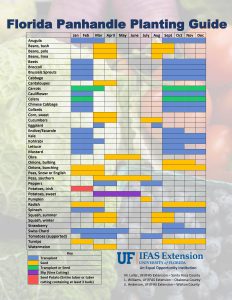

by Joshua Criss | Nov 21, 2024
A Sea of Yellow
You do not often see a sea of yellow flowers on what was recently a field of row crops in North Florida. In this instance, the culprit is a cover crop called sunn hemp (Crotalaria juncea). Cover cropping, or green manure as it is sometimes known, is not a new concept. It is a great method for improving soil quality, adding organic matter, augmenting nitrogen supply, supporting pollinators when resources begin to wane, and combating nematodes. Incorporating this sustainable agriculture practice into home vegetable gardens is an excellent method to build long-term viability and production.
Many plants may be used in this capacity, but this article will focus on sunn hemp. This annual is an herbaceous, short-day flowering plant in the Lamiaceae or legume family. Its erect stems produce a great deal of biomass and, as a legume, will augment nitrogen stores within your soil profile. As if that wasn’t enough to sell you, this plant is also known to suppress nematode populations. Native to India and Pakistan, where sunn hemp is grown for fiber, this plant grows well in tropical and temperate environments. It will thrive in even sub-par conditions and requires little fertilizer input.
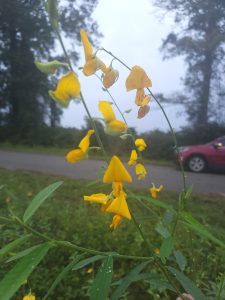
UF/IFAS Photo: Josh Criss
Seed Time
Seed this plant once your summer gardens have begun to wane. The shorter day length will keep the plant confined to about 3-4 feet while still allowing it to flower. It may also be planted earlier in the year to maximize below-ground biomass and add organic matter. In this scenario, the plant will likely grow to 7 feet tall with a closed canopy within 10 weeks.
Sunn hemp requires little fertilization as it is a legume, a plant family known to fix nitrogen from the atmosphere. This same mechanism is one of the features of this plant as a cover or green manure crop, as it can add up to 320 pounds of nitrogen per acre back to the soil when planted en masse.
Seeding rates within a home garden are much smaller. A farmer may plant 30-50 pounds of seed, which is not practical in small-scale growing. Instead, aim to cover the garden area through broadcasting seed, as a denser planting will reduce the later branching of this plant. Ensure you have 8-12 weeks of warm, frost-free weather, and terminate them prior to reaching the full bloom stage. Doing so will provide your gardens with the same benefits seen in farm fields utilizing this sustainable practice.
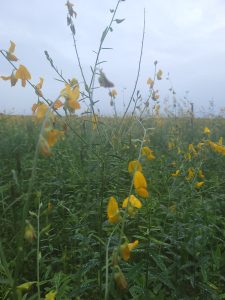
UF/IFAS Photo: Josh Criss
To Sum it Up
Sunn hemp is an excellent plant for your gardens before your fall greens. The biomass it produces and the nitrogen it recovers make it very attractive to farmers and should raise eyebrows even in the home garden. The trick is learning to manage this plant within your crop rotation. For more information on soil management refer to these IFAS documents, or contact your local extension agent for additional information on this and any topic regarding your gardens and more.
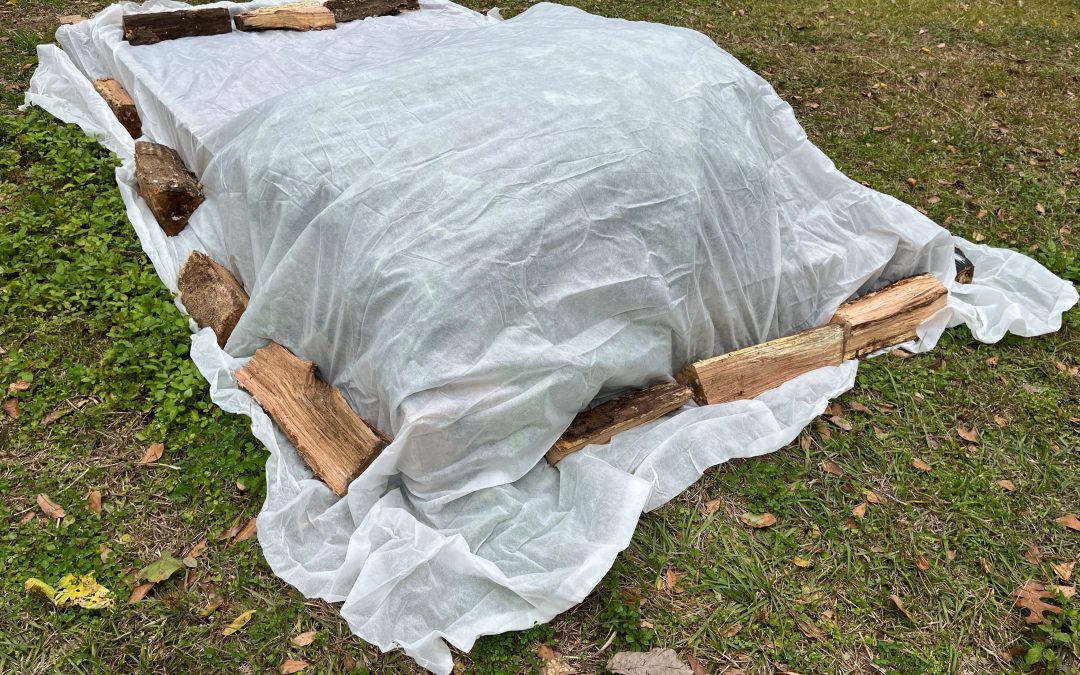
by Molly Jameson | Nov 6, 2024
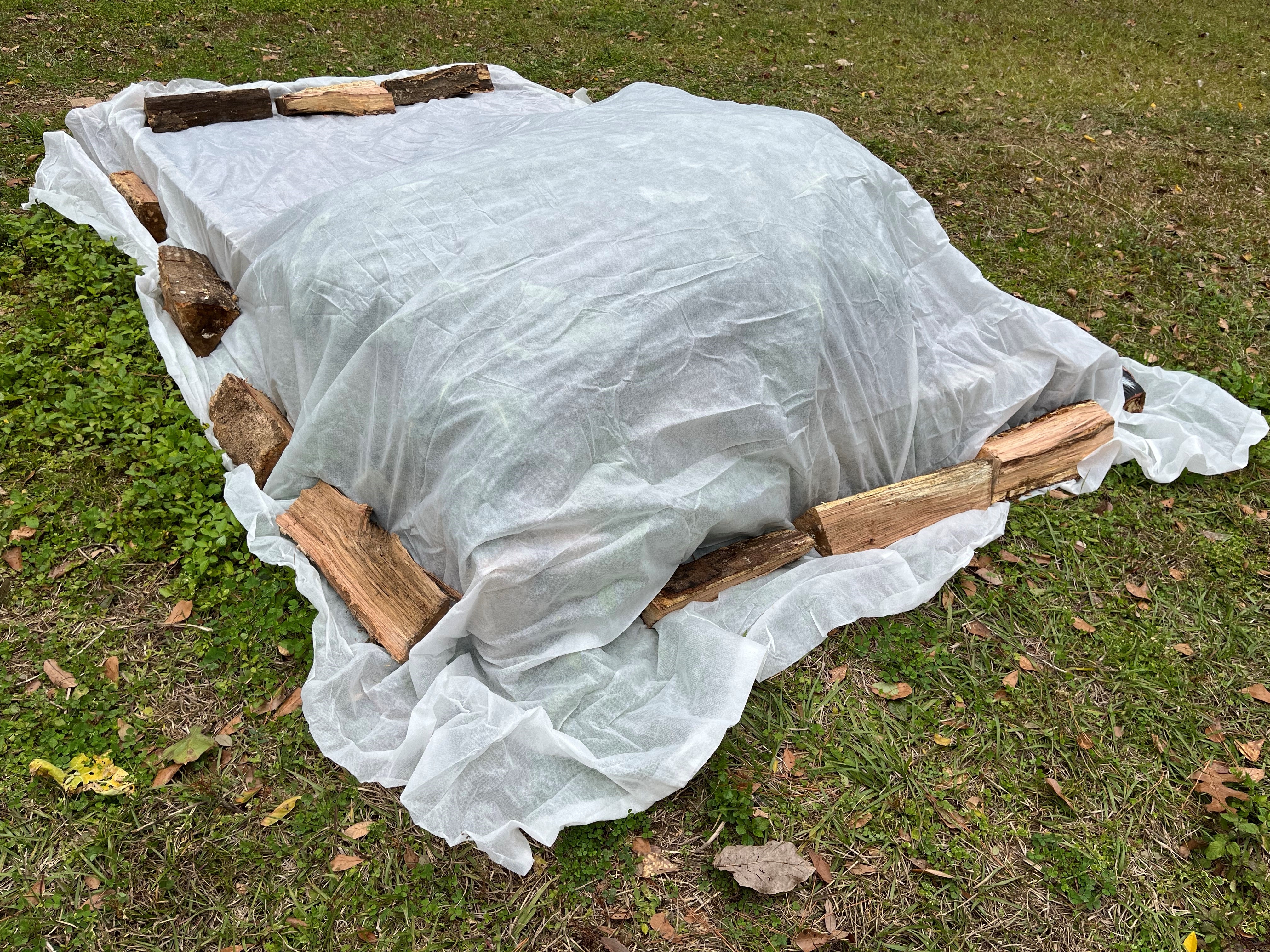
Anchor frost cloth securely to keep it tightly in place, as removing air gaps helps trap ground heat and shield plants from cold air. Photo by Molly Jameson.
Here in North Florida, mild winters are the norm, but our occasional cold snaps can be enough to wreak havoc on our gardens. As you might remember, in December of 2022 the entire Panhandle experienced temperatures dipping into the teens and low 20s for several nights in a row, with some areas reaching as low as 18°F. This kind of unexpected freeze can catch even the most experienced gardeners off guard.
While plant covers are the go-to solution for many of us, pairing them with additional techniques can offer even better protection when temperatures dip. From common cold weather protection myths to practical DIY tips that enhance your plant cover’s effectiveness, knowing your options can make all the difference during an impending cold snap.
Cold Protection Myths and Misconceptions
When a frost or freeze warning hits, there’s plenty of advice flying around. Some of it’s helpful, and some, not so much. Here are a few misconceptions to clear up:
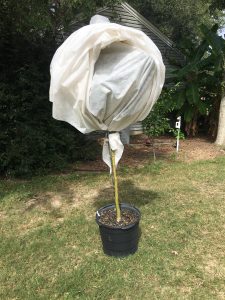
“Lollipop” trees will allow the heat from the ground to escape, giving the tree no cold protection. Photo by Jonathan Burns.
- “It’s All About Covering the Leaves”
Many gardeners believe that simply covering the leaves of their plants will provide adequate protection. However, this can lead to what’s commonly referred to as “lollipop” trees, where only the foliage is covered, leaving the trunk exposed. This is problematic because cold air can still penetrate, and the heat rising from the ground isn’t captured effectively. To ensure proper protection, the plant cover should touch the ground all around the plant to trap heat radiating from the soil, providing insulation from below. For best results, choose a medium-weight frost cloth (about 1 to 1.5 oz/yd²) made from breathable polypropylene or polyester fabric. These materials offer excellent insulation, providing about 4 to 8 degrees of temperature protection, depending on factors like cloth weight, ground heat trapped, and wind conditions. Frost cloth also allows moisture and air exchange, which helps prevent overheating on sunny days.
- “A Plastic Sheet Works Just as Well as Frost Cloth”
Throwing a plastic sheet over your plants might seem like an easy fix, but it often leads to more harm than good. Plastic is non-breathable, which can trap condensation and freeze on the plant’s surface. It also doesn’t insulate well, transferring cold temperatures directly to the leaves and stems. If you must use plastic in a pinch, make sure it doesn’t touch the plants directly and that it’s securely anchored to the ground to effectively trap warmth. Be sure to remove it in the morning once temperatures start to rise to avoid overheating.
- “Covering Your Plants Alone is Enough”
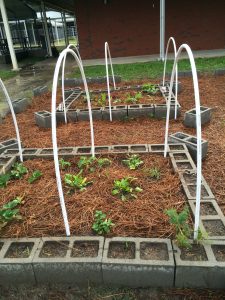
With PVC hoops ready to hold frost cloth and a thick layer of pine straw mulch, these raised beds are prepped for whatever winter throws their way. Photo by Molly Jameson.
While covering plants is crucial, sometimes additional steps can make a big difference. Mulching around the base of plants with a thick layer of pine straw or leaves helps insulate the soil and trap ground heat. It’s a small step that offers big protection to the roots and lower stems.
- “Watering Plants Before a Freeze Doesn’t Help”
Watering the soil around your plants before a freeze is a good practice because moist soil retains heat better than dry soil. This can help keep the root zone warmer overnight. However, it’s important to focus on watering the soil rather than the leaves. Water on foliage can freeze and cause damage, so it’s best to keep leaves dry as the temperatures drop. A deep watering a day or two before the cold hits is ideal for giving your plants a fighting chance.
DIY Cold Protection Solutions
If expensive greenhouses and plant covers are out of your budget or you want to get creative, there are plenty of do-it-yourself solutions for protecting your plants:
- Recycled Materials as Frost Protection
Old bedsheets, towels, or even buckets and cardboard boxes can be used in a pinch to cover smaller plants. Just be sure to anchor them down well, so they don’t blow away.
- DIY Hoop Houses
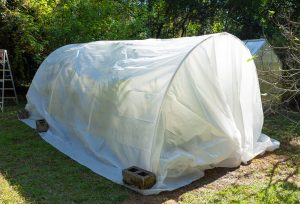
A temporary hoop house can be constructed using PVC pipes as the frame and polyethylene film as the covering to protect cold-sensitive plants during freezes. Photo by David W. Marshall.
For taller or sprawling plants, construct simple hoop houses using PVC piping with breathable frost cloth or lightweight plastic sheeting. Unlike placing plastic directly on plants, hoop houses create an air gap between the plastic and the plants, which helps trap heat from the soil while preventing direct contact damage. If using plastic, seal it tightly at night to trap warmth, and open it partially during the day to prevent overheating or excessive moisture buildup as temperatures rise. These low tunnels are perfect for garden beds or fruiting plants that need a little more room under cover.
- String Lights for Added Warmth
For extra protection, consider using outdoor-rated incandescent string lights (not LEDs, which don’t produce heat). Drape the lights around or near the plant under the covering to create a gentle source of warmth, which can raise temperatures by a few degrees on especially cold nights. For fire safety, keep lights from direct contact with dry materials and use only moisture-safe, outdoor lights.
- Windbreaks to Stop the Chill
In areas with open landscapes, cold winds can make frost damage even worse. Planting a hedge or using temporary barriers like hay bales or pallets can shield your garden from icy gusts and protect your more delicate plants.
Long-term Planning: Choose Cold-Tolerant Varieties
One of the best ways to prepare for cold snaps is to plant cold-tolerant varieties suited to North Florida’s climate. Vegetables like collards, kale, and carrots, or perennials like rosemary and garlic chives, can withstand mild freezes with little effort. If you’re growing fruit trees, look for varieties with proven cold tolerance or dwarf varieties that are easier to cover.
With a little planning and a few simple techniques, you can protect your garden from unexpected cold spells and keep it thriving through our chilliest nights.
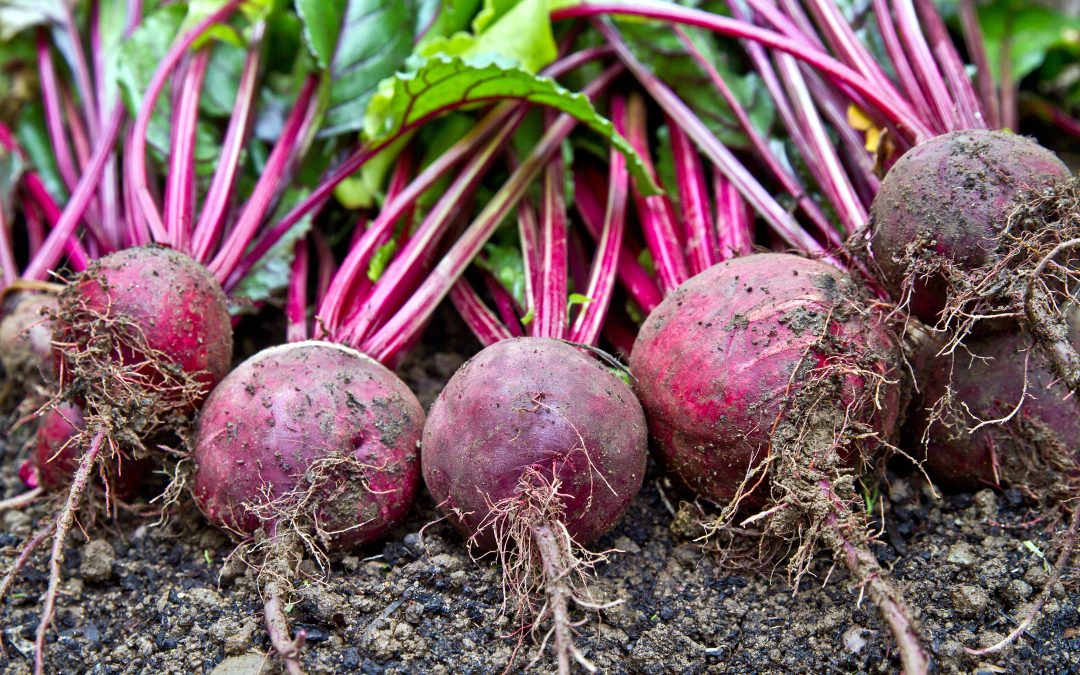
by Molly Jameson | Sep 30, 2024
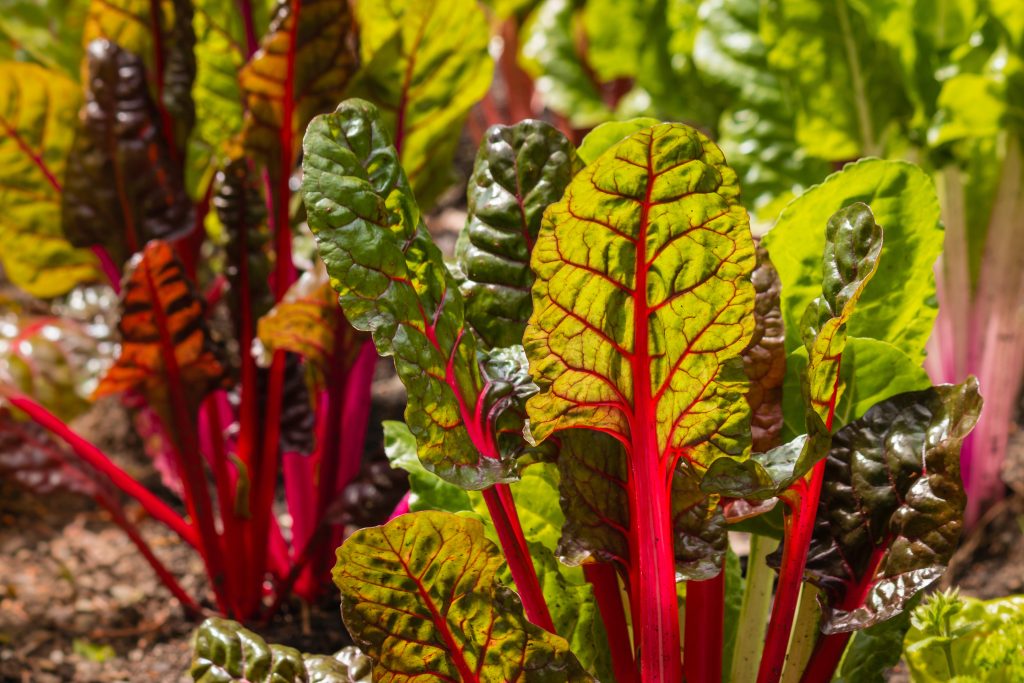
Swiss chard thrives in cooler weather, producing a continuous harvest of large, glossy, deep green leaves with colorful stems in shades of white, red, and yellow. Photo by Patrik Stedrak, Adobe Stock.
At first glance, beets and Swiss chard might seem like entirely different plants. Beets are known for their edible, bulbous root, while Swiss chard is grown for its large, leafy greens and colorful stems. However, both belong to the same species, Beta vulgaris, in the Amaranthaceae family, and their differences are the result of selective breeding over time.
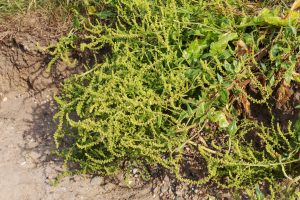
Wild sea beet (Beta vulgaris subsp. maritima), native to Mediterranean and coastal European regions, is the ancestor of cultivated beets and Swiss chard. Photo by Thorsten Schier, Adobe Stock.
Both beets and Swiss chard originate from the wild sea beet (Beta vulgaris subsp. maritima), a plant native to Mediterranean and coastal European regions. Ancient civilizations, such as the Greeks and Romans, bred beets for their enlarged roots, which eventually became the garden beets we know today. Despite its name, Swiss chard isn’t from Switzerland – it was also cultivated in the Mediterranean, bred for its nutritious leaves and stems. The “Swiss” name was added in the 19th century by seed catalog publishers to distinguish it from French spinach varieties.
Both beets and Swiss chard are highly nutritious. Beets, which range in color from deep red to golden yellow, are rich in vitamin C, folate (B9), and essential minerals like manganese, potassium, magnesium, and iron. They contain betalains, antioxidants with strong anti-inflammatory properties, and are a great source of fiber and nitrates, supporting digestion and heart health. Beets can be cooked in a variety of ways, offering a sweet, earthy flavor that intensifies when roasted. They can also be boiled, steamed, or eaten raw in salads, pairing well with tangy ingredients like citrus and goat cheese.
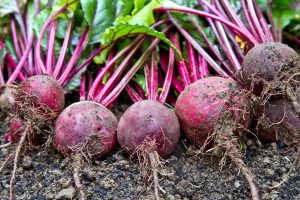
Beets can be grown in the fall and winter in the Panhandle, yielding round, bulbous roots with a sweet flavor and earthy aroma. Photo by Clickmanis, Adobe Stock.
Swiss chard, with its large, flavorful leaves and vibrant stalks in red, yellow, and white, is packed with vitamins A, C, and K, as well as minerals like magnesium, potassium, iron, and calcium. It also contains antioxidants like beta-carotene, lutein, and zeaxanthin, which support eye health and combat oxidative stress. Its high levels of potassium aid in electrolyte balance and heart health, while vitamin K and calcium contribute to strong bones. Swiss chard can be sautéed, added to soups, or eaten raw in salads, with both the leaves and stems being edible.
Essentially, beets and Swiss chard are different forms of the same plant, bred for either the root or the leaves. This explains why beet greens are similar in flavor and texture to Swiss chard, though beet greens are usually smaller and more delicate. Beets provide the advantage of both edible roots and greens, while Swiss chard offers vibrant, nutritious leaves that can be harvested throughout the season. Both crops thrive in cooler weather, making them ideal for fall and winter planting in the Florida Panhandle.


















